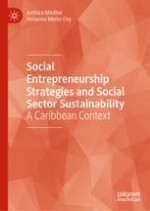2023 | OriginalPaper | Chapter
3. Social Entrepreneurship Strategies for NPOs’ Organisational Sustainability
Authors : Ambica Medine, Indianna Minto-Coy
Published in: Social Entrepreneurship Strategies and Social Sector Sustainability
Publisher: Springer International Publishing
Activate our intelligent search to find suitable subject content or patents.
Select sections of text to find matching patents with Artificial Intelligence. powered by
Select sections of text to find additional relevant content using AI-assisted search. powered by
